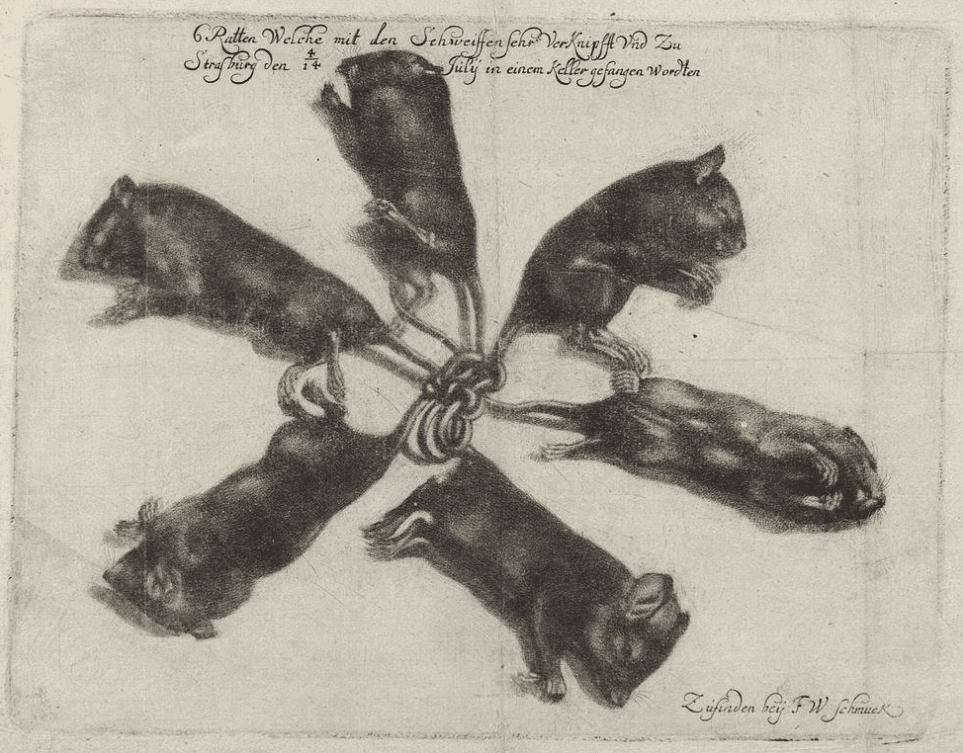Last updated on November 17th, 2023 at 12:59 am
In the darkest, weirdest corners of folklore, a phenomenon known as the ‘rat king’ emerges.
It is a fascinatingly disturbing creature composed of many squealing, wiggling rats held together by a bunch of tangled tails. It is both captivating and repulsive, a visual representation of nature’s ability to create chaos.
Historically, rat kings are considered a sort of natural curiosity. They are often associated with superstition and folklore. They’ve been mentioned in literature and legend across different cultures. And they are often depicted as a bad omen or a sign of doom.
Some even suggest that rat kings possess supernatural powers or that their appearance portends a plague or calamity. But what are they? Do they truly exist? Or are the specimens we find simply hoaxes, meant to deceive and add to the mystery?
To understand the enigmatic rat king, where reality and myth intertwine, we must unravel the mysteries behind this rare and captivating phenomenon.

What is a Rat King?
A rat king is an intriguing and rare phenomenon where a group of rats becomes intertwined and bound by their tails, creating a tangled mass of small creatures. This occurrence is extremely unusual and has been reported sporadically throughout history. It’s considered quite rare.
The tails can become tangled due to various factors, such as adhesive substances, entangling materials, or accidental entanglement. Similar incidents have even occurred with squirrels. The so-called “squirrel king” provides further evidence for this phenomenon.
The origin of the term ‘rat king,’ is a bit more unclear and hard to pin down. It is believed that the name originated from the German word “Rattenkönig,” which was later translated into English.
The name was initially metaphorical. It referred to people who lived off others. It symbolized parasitic behavior. But over time, it came to depict a king perched upon a throne of knotted tails or even a spinning wheel of rats.
It’s uncertain which came first – the name or the real thing.
Earliest Reports of the Rat King
The earliest report of rat kings dates back to 1564. This marks the beginning of the documented sightings of these peculiar entangled creatures.
During the Middle Ages, the Black Death ravaged Europe. Rats were falsely believed to be carriers of the deadly plague. However, it was later discovered that it was from the fleas, not the rats.
It was during this time, though, that stories began to spread about nests of rats with their tails knotted together. The discovery of such a tangled group was considered a dire omen. This led to the coining of the term “rat king.”
Various rat species can form rat kings, but most of the examples and sightings consist of black rats.
Sightings and reports of rat kings persisted over the following centuries. Several preserved specimens of rat kings are even exhibited in museums across Germany and France, where the reports have historically been most prevalent.
Meanwhile, the renowned Mauritianum Museum in Altenburg, Germany, proudly displays what they claim to be the largest known rat king found. It was discovered in Buchheim in 1828 by a miller cleaning out his fireplace. His extraordinary specimen is an entanglement of an unbelievable 32 dead rats!
Even More Sightings Throughout History
In 1930, there was a remarkable rat king discovered in New Zealand. It is now proudly displayed at the Otago Museum in Dunedin. It is composed of young rats whose tails were intricately entangled by none other than horse hair.
Similarly, in 1963, a Dutch farmer stumbled upon another rat king in Rucphen, Netherlands. Although all seven rats were deceased by the time they were examined, X-ray images revealed callus formations at the fractures of their tails. This indicates that these resilient creatures survived for an extended period with their tails tangled.
While modern sightings of a live rat king are exceedingly rare, a notable event, witnessed by a vigilant farmer, occurred in 2005 in Saru, Estonia. The rat king found, now housed in the University of Tartu Natural History Museum, contained live rats. This provided a unique opportunity for study.
A more recent sighting from 2021 near Stavropol, Russia, captured on video, showcased a living rat king composed of five mice.
Altogether, there have been dozens of rat kings recorded throughout history – but are they real?

Is It Real? Or Just a Hoax?
The authenticity of most rat kings has long been a subject of debate. Skeptics question their existence and raise doubts due to limited evidence.
The discovery of a live rat king in Estonia in 2021 has provided compelling proof that this phenomenon could indeed be a natural occurrence, albeit extremely rare.
But concerns are raised regarding the authenticity of centuries-old preserved museum specimens. Some think these are hoaxes or “sham kings.” Many likely are.
But naturalists have proposed numerous hypotheses to explain the phenomenon. These include the hypothesis that rats get stuck together during birth and become glued together. Or sometimes it could be possible that healthy rats intentionally knot themselves.
A plausible explanation revolves around the long, flexible tails of black rats, which could come into contact with a sticky substance, like tree sap. As they sleep, this mixture solidifies. I the rats realize they are bound, they may struggle, unintentionally tightening the knot.
Zoologists remain skeptical though. They question the long-term survival of rats in such entangled conditions, particularly if the rats begin biting their own or others’ tails in an attempt to free themselves.
However, experts acknowledge the possibility of isolated freak accidents, considering occasional cases involving squirrels. Ultimately, a study conducted in 2007 concluded that while naturally occurring rat kings are possible, they are indeed rare.
A Fascinatingly Gross Phenomenon
The fascinating, yet gross phenomenon of the rat king continues to intrigue and bewilder.
Skeptics still question their authenticity and some evidence may be tainted by hoaxes. But the discovery of live instances, such as the one in Estonia in 2021, provides compelling evidence of their natural occurrence.
The entanglement of rat tails, attributed to various factors like sticky substances and winter clustering, may create these peculiar clusters. Rat kings are captivating reminders of the mysteries that exist within the animal kingdom.
References
Stoddard, Christine. “The Myth of the Rat King.” Quail Bell Magazine, January 7, 2012. http://www.quailbellmagazine.com/the-real/the-myth-of-the-rat-king.
Taylor, Rupert. “The Mythology of the Rat King.” Exemplore, August 3, 2022. https://exemplore.com/legends/The-Mythology-of-the-Rat-King.

